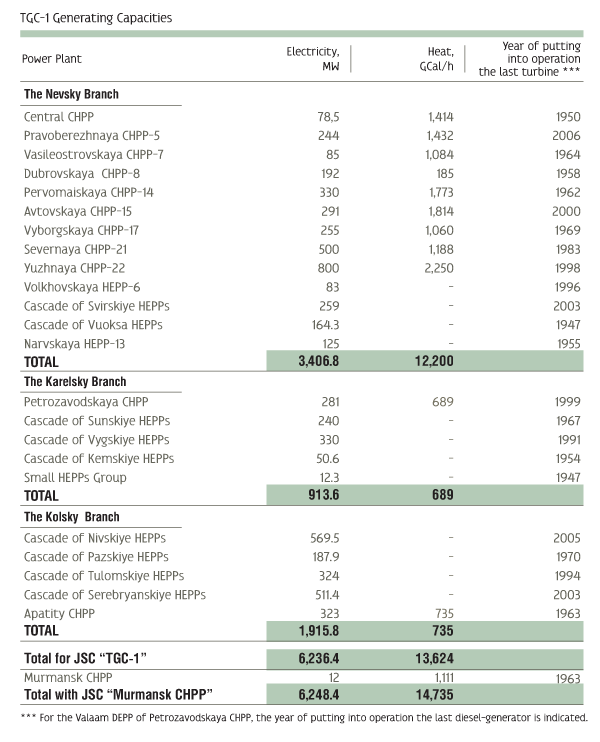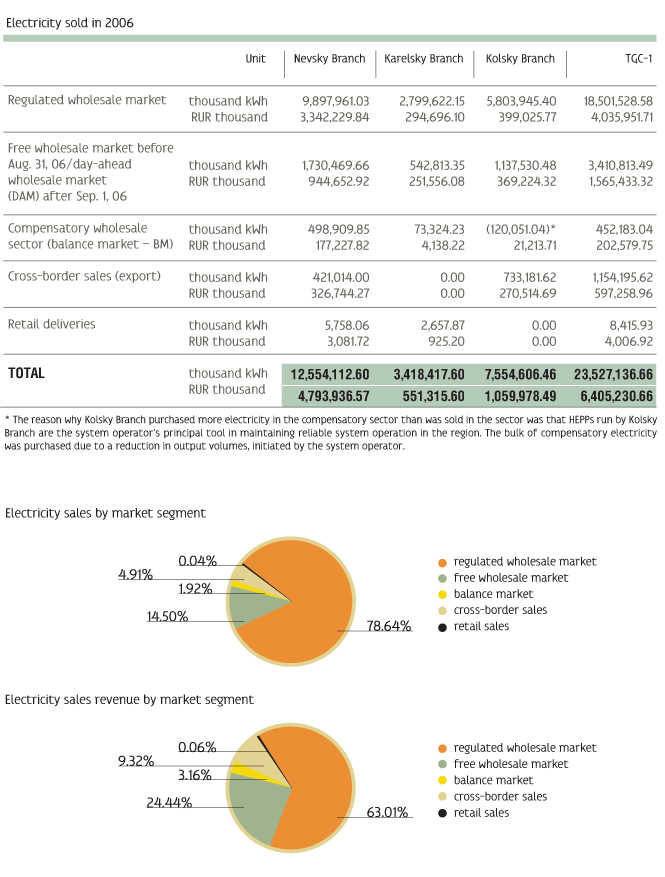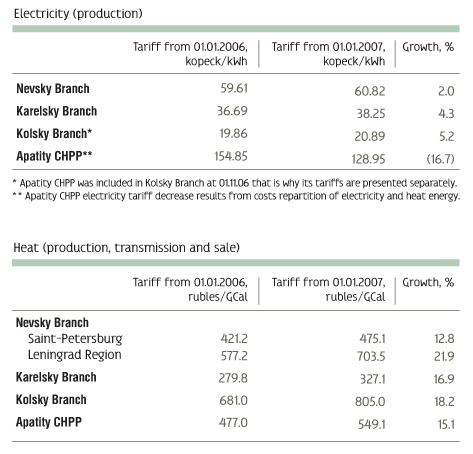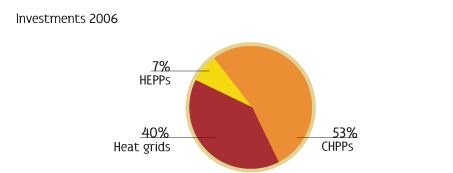 |
Annual report 2006 JSC "TGC-1" |
 |
8. BUSINESS ACTIVITY
8.1. PRODUCTION
8.1.1. Generating Capacities
JSC “TGC-1” facilities comprise 11 CHPPs*, 40 HEPPs, 1 DEPP and JSC “Murmansk CHPP”, which shares are in trust of TGC-1**. In 2006 the installed capacity of TGC-1 power plants was 6,236.4 МW (6,248.4 including JSC “Murmansk CHPP”), and the operational capacity made 3,453.1 МW. TGC-1 coefficient of the installed capacity efficiency was 55%, including 68% at HEPPs and 45% at CHPPs.

8.1.2. Heat network
JSC “TGC-1” operates a total of 946.1 km of heat networks, including the grids of JSC “Murmansk CHPP”.
Nevsky Branch of TGC-1
The Nevsky Branch of JSC “TGC-1” has 794.7 km of heat networks 200 to 1,400 mm in diameter in terms of one pipe calculations as of December 31, 2006.
Karelsky Branch of TGC-1
The total length of heat networks of the Karelsky Branch of JSC “TGC-1” is 20.3 km in terms of one pipe calculations.
Kolsky Branch of TGC-1
The total length of heat networks of the Kolsky Branch of TGC-1 is 29.5 km 150 to 700 mm in diameter in terms of one pipe calculations.
JSC “Murmansk CHPP”
The city of Murmansk receives its heat supply mainly from the Murmansk CHPP, which operates 101.6 km of heat network, 70 mm to 400 mm in diameter in terms of one pipe calculations.
8.1.3. Fuel supply
The main fuel for TGC-1 power plants is natural gas, accounting for 94.2% of the Company’s fuel balance in 2006. The remaining fuel needs were supplied by fuel oil (4.7%) and coal (1.1%)*.
* Apatity CHPP joined TGC-1 Kolsky Branch on November 1, 2006, thus 2006 figures are shown inclusive of Apatity CHPP figures for the period from November 1, 2006 to December 31, 2006.

TGC-1 receives its natural gas from Peterburgregiongaz, a Gazprom’s subsidiary. Quotas for rate-controlled gas supply to the Company are set (based on “tariff limits”) at the beginning of the year in consultation with Peterburgregiongaz. When the Company’s gas needs exceed the annual tariff quota, TGC-1 and Peterburgregiongaz sign a supplementary agreement, subject to the availability of extra gas to supply.
However, there is no guarantee that additional gas will be available. To assure steady supply of electricity and heat to consumers, TGC-1 uses backup fuel options — fuel oil and coal — in its power plants. The only Apatity CHPP, run by Kolsky Branch, uses coal as the main type of fuel. In 2006, the average weighted prices for key types of fuel raised by 27.54% from 2005, but coal prices increased only by 3.9% and gas prices by 12.5%, while fuel oil prices soared by 160.8%.
Weighted average prices for key types of fuel of CHPPs increased in 2006 on average by 27.54% as compared with the year 2005, as that the coal prices increased by 3.9%, fuel-oil — 160.8%, gas — 12.5%.

In 2006, TGC-1 power plants were supplied 135,000 tons of coal, 264,100 tons of fuel oil, and 5,237 million m3 of gas, and spent 113,800 tons of coal, 211,700 tons of fuel oil, and 5,237 million m3 of gas.

As of December 31, 2006, TGC-1 had leftover stocks of 396,000 tons of coal and 196,900 tons of fuel oil.
8.1.4. Electricity and heat output
TGC-1 power plants generated 23,242,400 thousand kWh of electricity in 2006, down 3.8% from 2005 as output dropped at hydroelectric plants due to lower water level in the rivers*.
22,852,268 GCal of heat flowed to consumers from the collectors of TGC-1 power plants in 2006, down 3% from 2005*. The drop was due to unusually warm weather in the 4th Quarter of 2006.
* The figure includes the output of Apatity CHPP from November 1, 2006 to December 31, 2006, but excludes JSC “Murmansk CHPP”.
8.2. SALES
8.2.1. Electricity
The Company sold a total of 23,527,136 million kWh of electricity worth RUR 6,405,230 million in different market segments in 2006. 78.6% of all electricity was sold on the regulated wholesale market, contributing 63% of the Company’s electricity revenue. Another 14.5% was sold on the free wholesale market (24.4% of total revenue), and 1.9% on the balance market (3.16%).

Export
TGC-1 exported 1,154,195 million kWh of electricity worth RUR 597.26 million in 2006. Exports contributed 4.9% of the Company’s electricity sales by volume, and 9.3% of its revenue.
Nevsky Branch exported electricity to Finland from its Cascade-1 plants: HEPP-10 and HEPP-11. Kolsky Branch also exported to Finland from the Cascade of Pazskiye plants: HEPP-4, 5, 6 & 7. Borisoglebskaya HEPP (HEPP-8) exported electricity to Norway.
Nevsky Branch exported electricity independently in 2006 under a ten-year contract with Fortum. Kolsky Branch exported via JSC “Kolenergosbyt” (retail supplies for export).
Purchased electricity
In the new wholesale market environment, TGC-1 from time to time purchased electricity in the day-ahead and balance segments of the wholesale market, in order to meet its contractual commitments on the regulated market. The Company outsourced 2,029.77 million kWh of electricity worth RUR 918.32 million in 2006. Furthermore, in a bid to minimize risk in the New Wholesale Electricity and Power Market (NOREM), TGC-1 and JSC “Kola Sales Company” signed a non-binding bilateral agreement, which TGC-1 used to purchase a further 31,285 million kWh of electricity worth RUR 4,599 million.
The Company, therefore, outsourced a total of 2,061.06 million kWh of electricity, worth RUR 922.92 million, in 2006.
Capacity sales
TGC-1 sold RUR 4,706.89 million worth of capacity in 2006, including:
- RUR 3,040.29 million to Nevsky Branch;
- RUR 829.44 million to Karelsky Branch;
- RUR 837.16 million to Kolsky Branch.

Before September 1, 2006, payments between consumers and suppliers of electricity were governed by two different policies, whereby regulators set a flat rate for consumers, but a dual rate (electricity and capacity) for suppliers. As a result, the regulated wholesale market was incurring cost imbalances that affected the composition of electricity/capacity sales revenues. At year-end 2006, RUR 334.45 million worth of tariff imbalances were reversed to sales revenue.
Technically, TGC-1 sold RUR 11,112.1 million worth of electricity and capacity in 2006, but after certain adjustments, performed by NP “ATS” (Trading System Administrator) following account reconciliation between supplies and consumers (RUR 683.31 thousand), and after the allocation of market imbalances from the compensatory sector, charged to TGC-1 in the amount of RUR 5,199.84 thousand, total 2006 electricity sales worked out at RUR 11,118 million, up RUR 5.9 million.
8.2.2. Heat
TGC-1 delivered 22,190,026 GCal of heat in 2006, including the 321,038 GCal that Nevsky Branch purchased from JSC “NPO CKTI” for resale. TGC-1 mainly sells its heat in St. Petersburg. Nevsky Branch supplied 91.1% of aggregate heat deliveries or 20,220,553 GCal in 2006. Karelsky Branch contributed 7.6%, or 1,680,832 GCal, and Kolsky Branch — 1.3%, or 288,641 GCal.

TGC-1 earned RUR 9,152,401 thousand on heat deliveries to its direct consumers in 2006. 46.8%, the highest percentage of heat was supplied to retail consumers, accounting for 56.3% of total heat sales. The other major customer group was wholesale consumers/resellers, who consumed 22.4% of heat deliveries and contributed 21.8% of heat revenue.
8.2.3. Tariffs
Since 2006 Federal Tariffs Service approves electricity tariffs for every plant. Heat tariffs are approved by regional regulating authorities for different groups of customers. There were the following tariffs set for JSC “TGC-1” composed of Nevsky, Karelsky and Kolsky Branches:

8.3. INVESTMENTS
In 2006, the Company’s investment plans focused on renovation and technical re-equipment of its energy facilities in St. Petersburg, the Leningrad Region, Murmansk Region and the Republic of Karelia, as well as new construction. The Company invested RUR 1,891.5 million in remodeling and technological refitting, and RUR 1,707 million in new construction.
TGC-1 invested a total of RUR 3,598.5 million in 2006. From that amount, its Nevsky Branch invested RUR 3,344.8 million; Kolsky Branch — RUR 150.3 million; and Karelsky Branch — RUR 103.4 million. TGC-1 mainly financed its investment projects with loans in 2006, having borrowed RUR 2,082.1 million. Another RUR 1,516.4 million were invested at the Company’s own cost.
TGC-1 invested RUR 1,907.6 million in its combined heat and power plants in 2006, representing 53% of the Company’s total investment, and RUR 1,443.5 million, or 40% of the total, in refurbishing its heat supply networks.

Completed investment projects
Nevsky Branch launched 180 MW generating unit at CHPP-5, built or remodeled shutters in large-diameter pipelines, and installed 57 units of spherical valves. The Branch also installed fire safety systems and security systems at its facilities as planned.
Kolsky Branch completed renovation of the turbine of a 38.5 MW hydro unit №3
at HEPP-3, and refurbished 150 kV outdoor switchgear (OSG) at HEPP-16, replacing VVB-150 switches with HPL-170 sulfur hexafluoride switches. The Branch also launched a brushless activation system for generator №2 at HEPP-7, and carried out preparatory work for upgrading unit №1 at HEPP-3, replacing obsolete equipment at all plants, and pre-investment research at HEPP-3, HEPP-5 and HEPP-13.
Karelsky Branch installed a wastewater bio-treatment facility and replaced surge suppressors OPN-330 and OPN-220 at Putkinskaya HEPP. The activation system was upgraded at Matkozhnenskaya HEPP. At Ondskaya HEPP, the 110 kV switchgear was replaced with hexafluoride switchgear, and control and security automation systems were upgraded. The branch completed refurbishment on in-plant pipes to its vapor cooling units RROU and BROU at Petrozavodsk HEPP, and shipped equipment to build a diesel power plant on Valaam Island. The Branch also launched an automatic process control system at Palyeozerskaya HEPP.
Next years investment plans
TGC-1 has drafted an ambitious investment program focused on improving the productivity and performance of its existing capacity, prolonging its life, and putting new capacity into action.
The investment program is ultimately aimed at boosting the Company’s industrial and financial performance by means of:
- extending the life of its generating equipment by replacing obsolete and fully worn equipment with modern, more advanced options;
- deploying new generating capacity;
- making its generating equipment more reliable.
The program envisages some 4,793 MW of new generating capacity to be installed before 2015, including replacement of 1,244 MW of existing capacity. Eventually, the Company plans to increase its installed capacity by 3,549 MW.
Replacement and modernization of heat networks in St. Petersburg is the

Company’s prior separate project. The project is important for TGC-1 not only for providing reliable heat deliveries to consumers, but for holding the leadership position at the heat market.
8.4. NEW TECHNOLOGIES
Introduction of new equipment and modern operating procedures aimed at improving the efficiency and reliability of operations is an important factor in achieving the goals that provide a reliable energy supply to the consumers of JSC “TGC-1”.
TGC-1 experts have worked out the program of modernization, technical re-equipment and reconstruction of plants aimed at complex replacement of worn-out generating capacities with new-day facilities.
Nevsky Branch
The Company’s Nevsky Branch put the following new technology into action in 2006:
Unit №1, launched at Pravoberezhnaya CHPP, took over the heat and electric workload of the older CHPP. The unit employs a sweeping automated process control system supporting fully functional, fully automatic unit operation in all modes according to job sequences programmed by the operator.
Planning commenced for an asset management system to ensure maximum returns on assets, while maintaining highly reliable equipment operation. The system will include separate modules for asset accounting and management, repair and maintenance scheduling, inventories and supplies management, as well as analytical and reporting modules.
Karelsky Branch
Karelsky Branch implemented a range of new technologies and equipment at its power plants in 2006:
- A microprocessor-based generator activation system went live at generators G-1 and G-2 of Matkozhnenskaya HEPP;
- Hard- and software package for SKBV, an axle pulse control system, implemented at units G-1 and G-3 of Matkozhnenskaya HEPP;
- Microprocessor devices for automatic precision synchronization purchased to replace older systems at the generators of Belomorskaya HEPP;
- Microprocessor protection and automatic switchgear controls installed at MSV 110 kV, Ondskaya HEPP;
- RETOM-VCm hard- and software package purchased to measure high-frequency values in relay protection line equipment, and HF values in the transceivers used for relay protection and emergency prevention signals.
Kolsky Branch
The Kolsky Branch of TGC-1 introduced no new technology or equipment in 2006 under the Company’s technological retooling action plan. The following equipment was installed for more reliable operation:
- Surveillance cameras at HEPP-19 of the Serebryanskye HEPPs Cascade;
- Charger/rectifier and 220V battery at Pazskye HEPPs Cascade;
- Activation system for a synchronous machine (brushless activator);
- Industrial invertors at Serebryanskye HEPPs Cascade.
Information technologies
The Company completed the following major IT projects in 2006:
- Automated Information and Measurement System for Commercial Electricity Counting (AIIS KUE) went into commercial operation at Karelsky Branch;
- Design for the deployment of current and voltage gauging transformers at Nevsky and Kolsky Branches. Current and voltage gauging transformers purchased for Karelsky Branch;
- Satellite communications installed to link Kolsky Branch facilities: Murmashi, HEPP-6, 10, 11, 15 and 18;
- Computers, networking systems and office equipment purchased for TGC-1 management and staff;
- Technical and Economic Operations Planning module developed for the CHPP technical support system;
- Phase 2 of the Geoinformation System for the St. Petersburg Heat Network developed and launched;
- Contract compliance IT system upgraded;
- The Target of Heat Supply in Contracts with Heat Consumers, Accounting Points for Contracts with Heat Consumers, and Contractual Value Estimates modules developed for the heat sales management system;
- Phases 1 and 2 of an integrated IT system for deliveries and purchases implemented at TGC-1;
- Consolidated financial reporting software developed for the Head Office, and Electronic Accounting System for TGC-1 divisions.
8.5. SOCIAL RESPONSIBILITY
Our social mission is to provide electric power and heat to meet the growing needs of citizens and the economy.
Our values are: safe, reliable and accessible electric power and heat supply; efficient use of energy and fuel; stronger partnership with consumers; health and safety of our employees; and minimal harmful impact on the environment. We will never accept any risk posing direct danger to human life, or threatening ecological disaster. We integrate these values into our business practices, and we prize the principles of openness and transparency in all our actions that effect society. We consistently reach out to a numerous cohort of interested parties
When we say TGC-1 has social responsibilities, we mean the Company’s responsibility to:
- Deliver the necessary amount of quality electric power and heat to conscientious users;
- Uphold the employment rights and provide a safe work environment for its employees, help them fulfill their personal and professional potential;
- Uphold good business ethics vis-a-vis contractors and suppliers, including by operating a transparent purchasing system;
- Honestly pay tax, support civil initiative, and otherwise contribute to socio-economic advancement at regional and local levels, which is our responsibility to society overall and to the local communities where our Company is present;
- Minimize adverse environmental impact for the future generations, which implies commitment to improving energy-efficiency and resource conservation.
The principles of corporate social responsibility became the driving factors of TGC-1 Development Strategy. We are convinced that, in the long run, sustainable development, financial growth, modernization of technical assets and increase in investment attractiveness can only be achieved through a sensible balance of interest between the Company, state and society.
Key social policy points for TGC-1:
- Social programs for employees and their families;
- Action to improve the work environment and employee health and safety;
- Promoting better performance and commitment to professional growth among the Company’s employees;
- Programs to assist the disadvantaged social groups;
- Social programs for children and teens;
- Philanthropic assistance to non-profit organizations and religious groups;
- Sponsorship of sporting organizations and institutions of culture, science and education;
Environmental protection and resource conservation:
- minimizing harmful environmental impact;
- programs for natural resource conservation.
Environmental Protection
As a Company poised for successful long-term growth, TGC-1 is committed to protecting the environment and using safer technology. In an electric utility company, industrial activity is always preceded by research and engineering for environmental safety, energy and resource conservation, and minimizing the environmental impact of HEPPs, CHPPs and heating grid operation.
The environmental policy at TGC-1 is centered on the following points:
- Rigorous compliance with environmental law;
- Consistent improvement of environmental protection performance;
- Prevention of adverse environmental impact.
In a bid to minimize negative environmental impact, the Company draws up annual action plans, while its divisions deploy dedicated environmental safety systems. The Company’s repair and upgrade schedule is designed for more productive heat and electric power generation, lower fuel consumption and minimal aerial emissions and dumping of pollution.
TGC-1 divisions take the following actions to implement resource conservation solutions:
- Construction or upgrade of process water recirculation systems;
- Construction or upgrade of wastewater treatment facilities;
- Installation of meters at water intake and outflow units on waterways;
- Revamp of temporary landfills for solid household and industrial waste;
- Implementation of smoke gas recirculation systems;
Automated emission monitoring systems.
In accordance with the Company’s Development Strategy it is planed to implement a number of investment projects by attracting funds from emission trading in compliance with article 6 of the Kyoto protocol.
Nevsky Branch invested RUR 105 million in fixed assets for environmental safety purposes as the final stage of its construction on unit №1 at Pravoberezhnaya CHPP-5 before unit launch. The project incorporated the following major environmental safety additions:
- Wastewater treatment facilities;
- Process water recirculation systems;
- Revamp of the sanitation system.
Karelsky Branch completed the following environmental projects:
- Container-type treatment facilities purchased and deployed for the biological treatment of household wastewater at Krivoporozhskaya HEPP, Kemskiye HEPPs Cascade;
- Oil discharger purchased and installed at Belomorskaya HEPP, Vygskiye HEPPs Cascade.
The Company invested a total of RUR 108.5 million in environmental safety in 2006 as a part of general nature conservation program which accounted for RUR 625.1 million.
Environmental management system
TGC-1 is currently working on its environmental management system conforming to GOST ISO 14000, designed to raise the Company’s environmental and social accountability at all levels.
The Environmental Policy Implementation Action Plan will enable the Company to:
- Reduce negative environmental impact;
- Increase the Company’s capitalization by securing reliable and environmental safe operation;
- Increase electric power competitiveness at the internal and external markets.
TGC-1 Board approved RAO “UES of Russia” “Environmental Policy Program” which implies development of the Company’s own environmental policy: ecological audit of the Company, corporate and international environmental management system observance certification, implementation of a long-term environmental action plan.
Human Resources
TGC-1 human resources policy keynote is to assure the achievement of the Company’s strategic targets by fully drawing on its human potential and encouraging employees to grow professionally.
TGC-1 pursues a human resources policy designed to strengthen employees’ confidence in the Company’s long-term economic continuity. Accordingly, the Company’s human resources management combines a system of internal relations and a system for tapping external sources of workforce.
TGC-1 human resources development means training, retraining and other professional advancement options for employees, as well as incentives to raise and nurture a workforce reserve and young professionals, bolstered by diverse corporate events and professional show-of-hand contests.
The main goals of staff training are:
- To bring employees’ qualification into line, and keep them aligned with a changing technological environment across the energy utility;
- Prepare employees for taking new positions;
- Tackle various technological and economic challenges;
- Propagate in-depth study and hands-on use of the latest achievements in science, technology and equipment, as well as best practice in production management and process optimization.
The human resources development priorities for TGC-1 are: to train a management reserve, facilitate higher vocational schooling for promising young workers, and help young professionals to plan their career.
Staff
TGC-1 employed 8,490 full time staff as of December 31, 2006, up 14.4% as compared with the year 2005.
Company-wide, the staff headcount increased by 1,069. While 71 were laid off in the non-production group, 1,137 new employees were hired for production.
Compensation and fringe benefits
In 2006, the average monthly wage at TGC-1 was RUR 22,955 thousand, having increased 21.3% since 4th Quarter 2005.
A range of new payroll improvements and performance incentives were introduced in 2006:
Following a salary market survey for specific positions and jobs in Saint- Petersburg and comparative analysis of salaries, the Company raised salaries for selective blue collar jobs at its power plants, and set a steady bonus for operators (shift staff), equaling 10% of their monthly wage.
In a bid to improve performance incentives for TGC-1 employees, the Company drafted and enacted a Policy on Additional Bonuses for TGC-1 Employees, rewarding employees for meeting key productivity targets. Under this Policy, employees received extra bonuses for the 2nd and 3rd Quarters of 2006 at TGC-1 divisions.
As required by the Russian Labor Code, all TGC-1 employees work on a contract basis. TGC-1 employees are entitled to a package of fringe benefits according to their Collective Labor Agreement for 2006 and 2007, signed on April 27, 2006 by TGC-1 General Director and Chairman of the Council of Primary Trade Union Leaders of TGC-1.
Among the perquisites available to employees are medical and resort services. The Company invests heavily in organizing enjoyable summer holidays for employees and their families.
The benefits package includes an optional health insurance program covering treatment at top medical centers and hospitals.
In 2006, the Company took out optional health insurance policies from Rosgosstrakh North-West for Nevsky Branch employees, and from ROSNO, for the employees of its Karelsky and Kolsky Branches. The new policies cover a much broader range of medical services compared to the previous edition, following the instruction of a number of new insurance plans. In addition to the regular in-patient, testing, outpatient, emergency and rehabilitation expenses, the new plans cover:
- Dental services;
- Health emergencies when traveling more than 500 km away from permanent place of residence in Russia;
- International travel insurance.
Human resources development
Employee training and evaluation are high priorities for the Company in its human resources development effort.
4.249 TGC-1 employees received professional retraining in 2006, including:
- managers 1,619
- specialists 1,246
- workers 1,384
The Company invested RUR 15.266 thousand in staff training in 2006.
TGC-1 reaches out to prospective and new young employees on a systemic basis, using the following policy instruments:
- Young Specialist Outreach Program;
- Policy on New Employee Orientation at TGC-1;
- Policy on Mentorship;
- Management Reserve Policy.
The effort is coordinated by the Young Specialists’ Council, tasked with coordinating outreach to employees younger than 35. The mission of the Council is: to promote professional growth, accelerate professional and social adaptation, strengthen corporate team spirit among young TGC-1 employees, and provide support for initiatives aimed at retaining young employees in the Company.
Social Programs
In the pursuit of its corporate development and social responsibility objectives, TGC-1 aims to advance science and education, promote and sponsor events in arts, culture and sports, and contribute to charity. TGC-1 is an active financial contributor to social and philanthropic initiatives assisting the disadvantaged social groups, especially children and the elderly. The Company has for many years contributed to the restoration of cultural and religious landmarks.
The management and employees of TGC-1 realize the importance of supporting philanthropic work at local and regional level, whether initiated by state-run or non-governmental organizations.
TGC-1 joins forces with non-profit organizations to develop meaningful social, environmental and cultural initiatives, and make them work.
TGC-1 always coordinates with business companies, non-governmental organizations and individuals committed to the pursuit of meaningful social work.
TGC-1 is dedicated to philanthropy and sponsorship.
2006 has seen implementation of more than 20 social projects in the following areas:
- Initiatives to assist the disadvantaged social groups;
- Support programs for children and teens;
- Philanthropic assistance to not-for-profit organizations and religious groups;
- Sponsorship of sporting organizations and the institutions of culture, science and education.
Support of Children, young people and school education
- Young Talents — support of gifted children from low-income families (together with the Children Protection Foundation);
- Implementing a new curriculum module “Power Industry. Basics of Safe and Economic Energy Consumption” into the Life Safety course at secondary schools (rewarded with the National PR prize “Serebryanny Luchnik” (Silver Ray) on January 25, 2006);
- Continuing traditional competitions in arts, literature and photography dedicated to power industry;
- Support of orphan homes and charity funds in regions.
Projects implemented jointly with higher educational institutions and secondary schools:
- Holding competitions of diplomas at higher educational institutions;
- Implementing the system of grants and scholarships;
- “Open Doors Days” for school children and students of power engineering higher schools;
- Practical training for students of regional power engineering higher schools;
- Olympiads and competitions of scientific-research works with subsequent publication best researches on the web-site of the company;
- Holding a Week of TGC-1 in power engineering higher schools.
Conservation of cultural and historical heritage:
TGC-1 is a constant partner of the State Academic Mariinsky Theatre;
Participation in the work of the Kronshtadt Historical Heritage Foundation;
- Support of the Russian National Glory Centre;
- Assistance in creating an I.A. Brodskiy monument;
- Support in the restoration of the G.O. Graftio monument;
- Support in the construction of the Church of Christ the Savior (in Srednyaya Rogatka);
- City festival organization: September, 23 — Leningrad Power Blockade Breaking.
Support of sports:
- Support of the Saint-Petersburg Track and Field Federation;
- Cooperation with the “Dynamo” basketball club.
One of high priorities for the Company in 2007 will be implementation of non-financial risks management system which will address the risks that may arise in the course of the Company’s operations. TGC-1 tackles the issues of discovering and managing risks based on the RAO UES concept of dealing with non-financial risks. This concept results from an international experience of risks management and that of Russian companies studying the effect of social and charity programs in optimizing non-financial risks. In accordance with this concept the damage or income measures of a risk situation are estimated basing not only on its direct effect on profit and loss and the price of Сompany’s shares but also on the effect on reputation and development of human capital as major non-material asset of the Company. More than this, it is also estimated based on the social and political effect it produces in the area of TGC-1 operation and in Russia in general. The following groups of risks are considered to be the most important for the Company’s current activities:
- Industrial risks;
- Production risks;
- State regulation risks;
- Corporate risks;
- Environmental risks;
- Fuel risks;
- Social risks;
- Reputation risks;
- as well as other risks associated with key parties involved in business and social operations of the Company.
TGC-1 is a company that is fully aware of its responsibility to the state and society. We are convinced that, in the long run, economic and social success can only be achieved through a sensible balance of interest between shareholders, the government, employees, suppliers, consumers, public institutions and other stakeholders — all those howsoever impacted by our business. We believe that in a society with a more favorable social climate, the climate for business is also better.